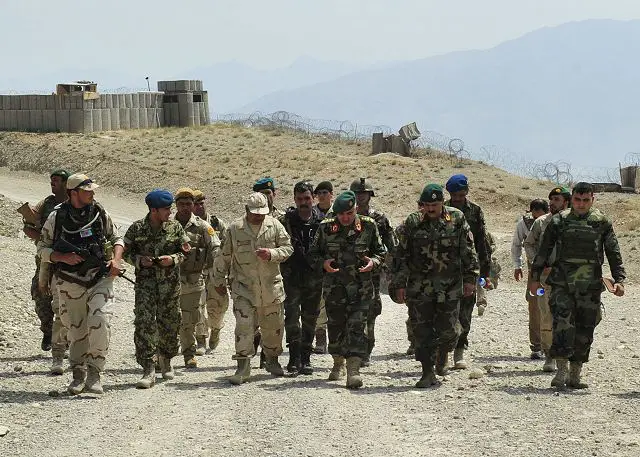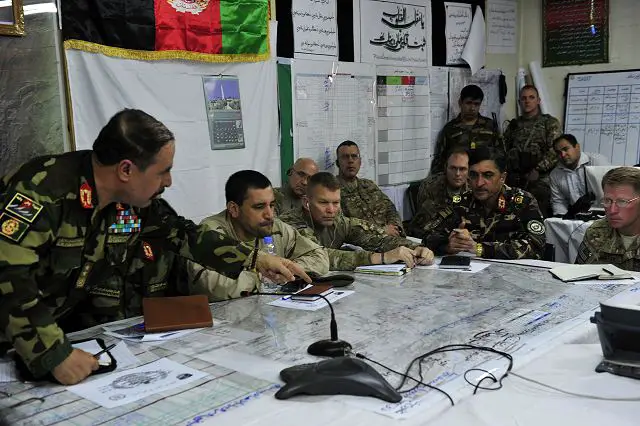Afghan National Army & Police worked together during combat operations in eastern Afghanistan 12008156
|
|
|||
|
Armies in the world - Afghanistan
|
|||
|
|
|||
| Afghan National Army & Police worked together during combat operations in eastern Afghanistan. | |||
|
Afghan National Army and Afghan National Police forces again demonstrated their ability to work together as a national security force this time during combat operations in eastern Afghanistan. Together, the ANA and ANP, along with other forces to include the Afghan National Civil Order Police, Afghan Uniformed Police, Afghan Local Police and air support from the Afghan Air Force conducted a clearing operation designed to disrupt networks of Taliban and other enemies of Afghanistan in Khogyani, Sherzad and Hisarak districts.
|
|||
|
|
|||
 Afghan National Army soldiers gather around to speak with their leader, Lt. Gen. Qadim Shah, the ANA Chief of General Staff Aug. 13, 2015. Afghan National Army soldiers gather around to speak with their leader, Lt. Gen. Qadim Shah, the ANA Chief of General Staff Aug. 13, 2015. |
|||
|
|
|||
|
In addition to clearing the districts of enemy forces, the ANDSF goal is to provide continued security for the area, which in turn will allow for better governance to the people. “There’s been great cooperation between the army and the police. They’ve come together for decisions about what to do, and then they employ the right tool to have the best possible effect, whether it’s an army tool or a police tool,” said Maj. Gen. Jeffrey Buchanan, Resolute Support’s deputy chief of staff for operations. “This is probably the best we’ve seen this level of cooperation of any operation to date this year.” Afghan Ministry of Defense and Ministry of Interior leadership planned and executed the operation together, with the coalition in the back seat acting in a train, advise and assist role. “The advisers play a critical role in the success in this operation, but it’s not to make things happen, what we want to do is ask leading questions, help the Afghans think about the best way to synchronize their efforts to achieve the best possible effect,” said Buchanan. The units participating in the operation along with Afghan National Police were the 111th Capital Division, the 201st Corps, and the 203rd Corps. “They were very successful. This is the first Corps-level operation for the 201st Corps this year. The Corps headquarters established a command and control echelon here [ANA Camp Khugyani],” said Col. J.B. Vowell, the deputy commander of Train, Advise, Assist Command – East, which provided the main advising effort for the operation. They integrated combined arms during the operation ... artillery, air engineers ... they’ve found and cleared over 150 IEDs and been able to maintain their time tables.”
|
|||
|
|
|||
 Lt. Gen. Qadim Shah talks with the commander of the Afghan National Army's 111th Capital Division during a battlefield circulation for Operation Iron Triangle, Aug. 13, 2015. Lt. Gen. Qadim Shah talks with the commander of the Afghan National Army's 111th Capital Division during a battlefield circulation for Operation Iron Triangle, Aug. 13, 2015. |
|||
|
|
|||
|
In addition to the large number of IEDs cleared throughout the operation, other successes included the reconstruction of damaged roads, as well as the successful use of artillery. Overall, more than 50 kilometers of road and towns were cleared of insurgent activity from Khogyani to Sherzad into Hisarak.
While the corps had initially planned for the operation to take nearly three weeks, the quick movements of the ANDSF allowed them to reach the Hisarak district center more than three days earlier than expected. “The plan is once the area of Hisarak is cleared we’ll organize another tribal leader meeting, and talk about the peace for the future in the area,” said Maj. Gen. Mohammad Zaman Waziri, the 201st Corps commander. “In the last 14 years, there have been no operations in this area ... this is the first time for joint operations here. Our main objective is Hisarak, it is a strategic district. The enemies in the area come from Pakistan into Hisarak, from here they deploy into Kabul.” Therefore, the clearing of this area will not only provide security for the local population in the districts, but also additional security for the capital city of Kabul. With the recent up-tick of attacks in the city, this operation plays a major strategic role in securing the city and preventing high-profile attacks. While the majority of the focus was in eastern Nangarhar, ANDSF did not ignore the emergence of Daesh and Taliban clashes in the west.
|
|||
|
|
|||
 Lt. Gen. Qadim Shah, the Chief of General Staff for the Afghan National Army, and Gen. M. Ayoub Salangi, the Deputy Minister for Security for the Ministry of Interior, along with senior coalition leaders listen to an operational update brief for Operation Iron Triangle, Aug. 13, 2015. Lt. Gen. Qadim Shah, the Chief of General Staff for the Afghan National Army, and Gen. M. Ayoub Salangi, the Deputy Minister for Security for the Ministry of Interior, along with senior coalition leaders listen to an operational update brief for Operation Iron Triangle, Aug. 13, 2015. |
|||
|
|
|||
|
“There’s been a lot of Taliban on Daesh fighting particularly in Nangarhar, and that played a role in Operation Iron Triangle,” said Buchanan. “The security forces could not ignore that fighting for fear of leaving the backdoor open while they focused in the west.”
Near the close of the operation, Gen. M. Ayoub Salangi, the deputy minister for security for the Ministry of Interior, and Lt. Gen. Qadim Shah, the chief of General Staff for the ANA, traveled with Resolute Support’s deputy chief of staff for operations, Buchanan, as well as the deputy chief of staff for intelligence, Maj. Gen. Mark Quantock, to the different corps participating in the operation. During their battlefield circulation, they were able to meet with the different corps leadership to receive operational updates and assess the accomplishments made thus far in the operation. At each location, both Salangi and Qadim Shah praised the efforts of their troops and acknowledged the sacrifices of those lost or wounded in battle. Salangi, when speaking with the leadership and elders at the 111th Division, commended the men for their dedication, stating, “Your beards have turned gray serving your country.” Qadim Shah noted their key to success was coordination, command and control and rapid response, but also encouraged them to continue their operations, and ensure a security perimeter would be established around the districts. Both leaders made it clear that while the initial goal is security for the area, the overall goal is to establish good governance for the people. The ANA chief of General Staff also directed each unit to develop an accurate after action report, capturing their successes, but more importantly, to look at where there were gaps and how they can improve in future operations.
|
|||


























